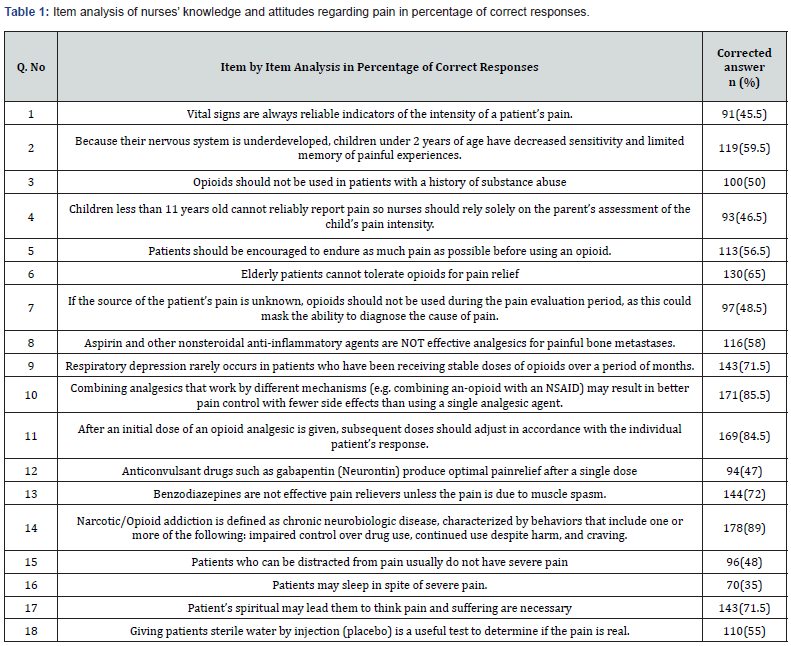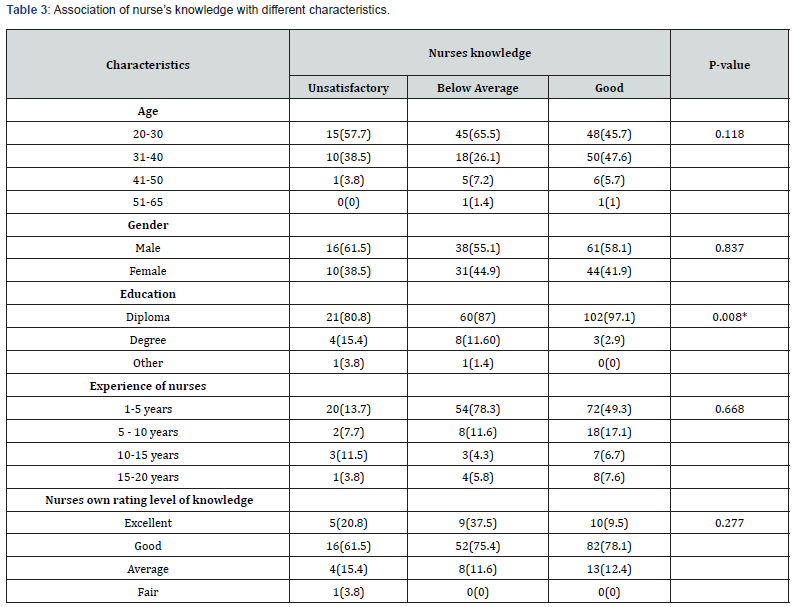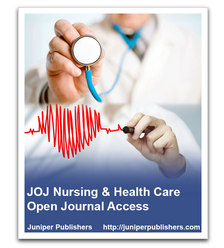Nursing & Health Care - Juniper Publishers
Abstract
Background
Disease process can be healed early if it is cured wisely and timely. Key role can be played by nurses in evaluating and managing pain. The nurse’s assessment, implementation, and evaluation of pain relief methods are critical for positive patient outcomes. The literature suggests that acute pain can progress into chronic pain if not dealt sensibly. Thus, the Knowledgeable nurse can play effective part in minimizing patient discomfort during post-operative period.
Aim
Methodology
Results
Conclusion
Keywords: Pain management, Postoperative pain, Medical professionals, Pain education, Liaquat national hospital, General surgery, Clinical experience, Analgesics
Introduction
Disease process can be healed early if it cured wisely and timely. Key role can be played by nurses in evaluating and managing pain. Nurses must be highly competent, knowledgeable and possess positive attitudes towards pain management so that patients receive high quality pain management practices to facilitate optimal patient health outcomes. The nurse’s assessment, implementation, and evaluation of pain relief methods are critical for positive patient outcomes [1]. The study conducted to assess pain knowledge revealed that the majority of the respondents i.e. 66% had average knowledge, 20% had poor knowledge and only 14% of respondents had good knowledge related to pain management. Knowledge of nurses towards pain management have an influence on how pain is managed, and their results showed that 64.5% registered nurses had inadequate knowledge and hence managed pain poorly [2].Acute pain can progress into chronic pain if not dealt sensibly. They reported limited knowledge toward pain management as one of the major obstacles to implement an effective pain management among nurses [3].
As reported, inadequate pain management is the source of major economic and human costs for patients, their families and society [4]. Nurses play a vital role in the management of patient’s postoperative pain which includes the assessment of the pain by eliciting the patients self-report of pain where possible in the determination of pain intensity on a regular basis and undertaking re-assessments of pain frequently [5].
It is believed by many that pain is the most typical motive for individuals to seek medical attention, as well as being the most frequently reported complaint made by patients [6]. It is also important to recognise that the approach to pain management is not simply a biological one, whereas Pain results from a dynamic and complex interaction among physiologic, psychological, and social factors by Br J Pain. 2016 [4]. Medical professionals’ inadequate knowledge in pain assessment and management has been pointed out as an important barrier to pain control [7].
Thus, the knowledgeable nurse can play effective part in minimizing patient discomfort during disease process. Pain education in general, were found to be effective in improving nurse’s pain regarding knowledge and patient outcome [8]. There is a lack of studies in our local population regarding knowledge of pain management among nurses. Above studies was the source of inspiration to conduct research at LNH, to assess nurses’ knowledge towards pain management.
Objective
The objective of this study is to assess the prevalence of knowledge regarding pain management in nurses working in the tertiary care hospital. As we will be introducing pain assessment tool for nurses in upcoming months.
Material & Methods
A cross-sectional survey was conducted in Liaquat National Hospital. Nurses who work in the Post Anaesthesia Care Unit (Operation theatre), Orthopaedic & Plastic surgery HDU, Surgical Intensive care unit (ICUs), General Surgery (HDU), General Surgery Male & Female Ward, Neurosurgery HDU and Gynea HDU were invited to participate in this study. The total 200 study participants were included in this study. This sample size was calculated using the WHO software, taking the prevalence of those participant who had good knowledge (P) =14% 1, margin of error = 5%, and confidence level 95%.
Inclusion criteria for the participants for the study was registered nurses working at LNH, at least 1 year of Clinical Experience, staff nurses who was present at the time of data collection and the exclusion criteria was students, trainees, less than one year of experience and staff nurses who did not agree to participate.
Participants written consent form was taken from all participants prior to participate in the study. The tool utilized for this current research study was ‘Nurses Knowledge and Attitudes Survey Regarding Pain’ (NKAS), which aim to elicit the level of knowledge regarding pain among nurses. In addition, we had used a one-page self-report to elicit the demographic characteristics of the respondents. It consists of 18 “True” or “False” questions it covers areas of pain management, pain assessment, and the use of analgesics [9]. The KAS has an established content validity by a panel of pain experts, which was based on the American Pain Society and World Health Organization, and the Agency for Health Care Policy and Research pain management guidelines [9]. No permission was required to use this KAS survey tool since the authors allowed its use for research. It was used in the English language since that nurses can understand and answer questions in English.
The recruitment of participants started after receiving approval from the researchers and ethical review committee from the Liaquat National Hospital Scientific Research committee Karachi Pakistan. Data were entered in a controlled manner, validate and check data, clean data, and export to SPSS (Statistical Package for the Social Sciences version 21.0) for analysis. Frequencies and percentages were computed for qualitative variables like gender, age group, level of education, years of experience and questionnaire regarding knowledge (T/F). Post stratification chi-square test was applied, and stratification was done by gender, age, level of education and years of experience to see the effect of these modifiers on outcome. P ≤0.05 will be considered as significant. Results are reported as percentages for categorical variables and as means and standard deviation (SD) for continuous variables. Independent t test was used to compare the mean total scores between gender and previous exposure to pain education. Analysis of variation (ANOVA) was used to determine the significant difference in the mean total knowledge score and educational level.
Results
Questionnaire based proforma was filled by the participants. Those participant nurses who respondent correctly that the correct answers of following statements are True were found as 70(35%) knew that the patient may sleep despite severe pain. 143 (71.5%) responses correctly that respiratory depression rarely occurs in patients who have been receiving stable doses of opioids over a period of months. 171(85.5%) nurses combining analgesics that work by different mechanisms (e.g., combining an NSAID with an opioid) which may result in better pain control with fewer side effects than using a single analgesic agent. 143(71.5%) beliefs correctly that patient’s spiritual beliefs may lead them to think pain and suffering are necessary. After an initial dose of opioid analgesic is given, 169(84.5%) participant nurses had knowledge that subsequent doses should be adjusted in accordance with the individual patient’s response. 144(72%) were responds correctly that benzodiazepines are not effective pain relievers unless the pain is due to muscle spasm. Narcotic/opioid addiction is defined as a chronic neurobiological disease, characterized by behaviors that include one or more of the following: impaired control over drug use, compulsive use, continued use despite harm, and craving was known by the 178 (89%) participants.
Those nurses who correctly stated that the correct answers of following statements are false, contributed as 91(45.5%) responses as the vital signs are always not reliable indicators of the intensity of a patient’s pain, 119(59.5%) responses correctly about the statement that children under 2 years of age have decreased sensitivity and limited memory of painful experiences not because their nervous system is underdeveloped. 96(48%) stated that patients who can be distracted from pain usually have severe pain. Aspirin and other non-steroidal anti-inflammatory agents are effective analgesics for painful bone metastases accepted by 116(58%) participants. 100(50%) stated that opioids should not be used in patients with a history of substance abuse was the false statement. 130(65%) nurses gave correct answer of elderly patients cannot tolerate opioids for pain relief. Patients should be encouraged to endure as much pain as possible before using an opioid was not accepted by 113(56.5%) nurses. 93(46.5%) nurses gave correct answer of statement that children less than 11 years old cannot reliably report pain so nurses should rely solely on the parent’s assessment of the child’s pain intensity. The detailed frequency distribution of corrected responded answers is presented in Table 1.

The mean corrected answers were 10.88±2.69. The mean of corrected answers was found 6.77±0.514, 9.25±0.69 and 12.97±1.75 in unsatisfactory, below average, and good level respectively. Mean percentage of corrected answers was found as 60.44±14.95. We found that most of the nursing staff has good knowledge and attitude regarding pain. The mean percentages of corrected answers were found 37.60±2.85, 51.36±3.85 and 72.06±9.72 in unsatisfactory, below average, and good, respectively. The knowledge level of nurses which assessed by the questionnaire was found as 26(13%) had unsatisfactory, 69(34.5%) had below average and 105(52.5%) participant had good knowledge regarding pain. The detailed frequency distribution of corrected responded answers is presented in Table 2. In our study, we found significant association of rating of nurse’s knowledge through questionnaire with education (p=0.008) while in significant association found with gender age (p=0.118), (p= 0.837), nursing experience (p=0.668) and nurses rate of their own knowledge (p=0.277). The detailed association of nurse’s knowledge with different characteristics is presented in Table 3.


Discussion
Two hundred nurses were enrolled in our study. Out of all these participants, there were 115(57.5%) males and 85(42.5%) females. There educational distribution comprised as 183(91.5%) had diploma and 15(7.5%) had degree. Most of the 70(68%) participants were young as they lie in the age range of 20-30 years. Their years of experience were found as 146(73%) had 1-5 years, 28(14%) had 5-10 years, 13(7%) had 10-15 years and 13(7%) had 15-20 years of experience. They all were from different wards such as 33(16.5%) from General surgery, 28(14%) from Gynae, 60(30%) from Medical intensive care units, 12(6%) from Nephrology, 10(5%) from Neurology high dependency unit, 10(5%) from Operation theater recovery, 20(10%) from Orthopedic and 27(13.5%) from Surgical intensive care units. Some of the nurses’ 107(53.5%) always assess pain with reference to change in vital signs while 55(27.5%) asses frequently, 20(10%) asses occasionally and 18(9%) asses rarely. We found that the most of the 150(75%) nurses had rate good level of their knowledge, 24(12%) had excellent, 25(12.5%) had average and only 1(0.5%) had fair knowledge. The detailed frequency distribution of corrected responded answers is presented in Table 1. This study shows that the level of knowledge regarding pain management among registered nurses in Karachi, Pakistan is low.
Nurses in this study had a mean total knowledge score of 60.44±14.95 and this is supported by findings in other studies that showed that nurses’ knowledge of pain management was poor ranging from 39.7 to 72.3 with knowledge score of pharmacology rarely exceeding 65% [10]. On the contrary, in their study of nurses’ knowledge and attitudes regarding pain in Northern Ireland Matthews and Malcolm (2007) reported a mean score of 73.8% which is more favourable that this present study [11]. Furthermore, our finding correlate with other respondents demonstrated knowledge deficits in the area when a substantial 96 (48%) of respondents falsely believed that patients who can be distracted from pain usually do not have severe pain [12].
An additional positive finding was that the participants demonstrated a good knowledge regarding children’s ability to accurately report their pain. Research has illustrated that children older than 3 years of age can reliably report their pain intensity level [13]. Most respondents [119(59.5%)] correctly believed that children who are less than 11 years old can accurately report their pain. These findings are consistent with that of other recent international studies that children can indeed accurately report their pain [5,11].
Another challenging concern was that almost more than half of the respondents in the present study 96 (48%) held the belief that patients with severe pain are unable to sleep. This finding is matching to Lui LY, So WK, Fong DY [14] who established that 52% of nurses in their sample believed patients who can sleep do not have severe pain. This finding also reflects the work of other researchers [15].
The mean score in this present study was higher than that of some reported empirical research studies which have been conducted internationally with a variety of nursing population’s especially reported by Rahimi‐Madiseh M, Tavakol M, & Lewthwaite BJ, Jabusch KM [16,17]. Furthermore, it was determined that almost 113(56.5%) respondents correctly understood that patients should not be encouraged to endure pain before using an opioid. This finding concurs with numerous previously documented research studies [15,16]. Pharmacological interventions for pain relief are the primary modalities for pain lessening in the acute care settings [12]. A significant number of questions based on pharmacology was asked to assess the knowledge regarding pain management. The score shows great knowledge deficits [18]. This also congruent with other research studies as pharmacology is the weakest part of majority of nurses regarding pain assessment and its management [15,16,18].
Conclusion
Overall, the findings in this current study have revealed extensive knowledge deficits in pain management. The mean correct answer rate in this study was only 50.37% which is significantly below the threshold of 80%. This study has provided an insight into the knowledge deficit of nurses working in tertiary care setup. The findings from this study reflect those of previously published international studies which reinforce the universal concern of the significant problem of inadequate knowledge of pain by nurses in caring for patients.
Limitations
The present study was limited to surveying nurses in 8 wards only which may have introduced bias. Additionally, the study sample was limited to nurses working within acute care areas, so it cannot be generalised to other sample populations of nurses. Furthermore, this study did not investigate nurses’ knowledge and attitudes regarding pain of patients with complex problems such as chronic pain states, cognitively impaired or non-verbal patients. Therefore, this limits the generalizability of the findings of the study as they may not be thoughtful of the larger population of nurses working in the acute care area.





No comments:
Post a Comment